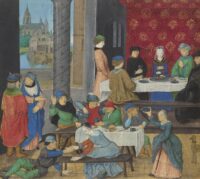More than 11 years ago when this blog was new (well… less old, at any rate), I wrote about medieval penitentials and the brilliant sex flowchart derived therefrom by University of Kansas history professor emeritus James A. Brundage for his seminal text Law, Sex, and Christian Society in Medieval Europe. It is still one of the most viewed posts in History Blog history.
Written by Irish monks starting in the 6th century, penitentials listed sins commonly encountered in confession and suggested suitable penances for each sin. They are remarkably explicit and specific in their descriptions of sinful sex acts, and the penances consistently prescribe rigorous fasting. A wide variety of sexual experiences — same-sex, extra-marital, marital but done at the wrong time, beastiality, masturbation — all earned the penitents years of fasting.
There was some discussion in the comments of what that level of fasting might entail. One comment from Mary clarified that a fasting penance in this context enjoined penitent sinners to abstain from certain kinds of food, not all food, mostly rich foods like meat and wine.
 I was reminded of this exchange when watching the highly entertaining and illuminating webinar Love, Lust, and Libido: Aphrodisiacs in Medieval Europe hosted by food historian Ken Albala and Getty manuscripts curator Larisa Grollemond. Albala explanes the Humor Theory and how inextricably linked it was to food which was not just a menu but medicine. What foods you were allowed to eat while doing penance for sexual sins was determined by the humors, because some ingredients — ginger, meat, salt — stimulated libido/performance/fertility while others — spinach, beans, fruit — suppressed them. Grollemond adds some visual aids in the form of manuscript illuminations from the Getty’s collection. It is an impressively thorough and eminently watchable treatment of the question.
I was reminded of this exchange when watching the highly entertaining and illuminating webinar Love, Lust, and Libido: Aphrodisiacs in Medieval Europe hosted by food historian Ken Albala and Getty manuscripts curator Larisa Grollemond. Albala explanes the Humor Theory and how inextricably linked it was to food which was not just a menu but medicine. What foods you were allowed to eat while doing penance for sexual sins was determined by the humors, because some ingredients — ginger, meat, salt — stimulated libido/performance/fertility while others — spinach, beans, fruit — suppressed them. Grollemond adds some visual aids in the form of manuscript illuminations from the Getty’s collection. It is an impressively thorough and eminently watchable treatment of the question.
Also not to be missed are three videos of Albala making recipes mentioned in the webinar. That almond milk creamed spinach from 1420 looks pretty great to me, especially if you add the garlic the author warned against as it is known to inflame lust.
A word or two, I would like to have with those, who fornicated the original user interface of the ‘Anglo-Saxon dictionary’ at bosworthtoller.com, rendering it ‘smartphone-compatible’ but entirely useless.
My “reconciliation” would truly be medieval! 👿 The ‘Anglo-Saxon dictionary’ might be doomed, but for the reconciliation there is a solution:
———
“In the course of the Counter-Reformation, the Bavarian Elector Maximilian I called Pauline monks to his country. They founded the monastery of Neudegg ob der Au in the Munich suburb of Au in 1627. The order imposed strict fasting rules on its members; among other things, only liquid food was allowed to be consumed during Lent.
The monks came from Italy, and fasting was difficult for them in the climatically harsher Bavaria. At first, they made do with “ainpöck” [“Single Bock”] beer from the Hofbräuhaus, which was not subject to the fasting rules. This strong beer was very high in calories, as it was relatively weakly fermented compared to today’s beers, and thus had a satiating and strengthening effect. The Paulans succeeded in obtaining a privilege to brew from Maximilian.
From 1629, they produced their own beer. In the process, they raised the original gravity again, thus obtaining a stronger and more satisfying beer than the “ainpöcksche” (a bock) from the Hofbräuhaus. The later name “Doppelbock” [Double Bock] goes back to this. In honor of its founder, St. Francis of Paola, it was brewed annually until April 2, the anniversary of his death, and called Herrenbier, St. Francis Oil, or St. Father’s Beer.”
———
cf.: en.wikipedia.org/wiki/Bock#Doppelbock